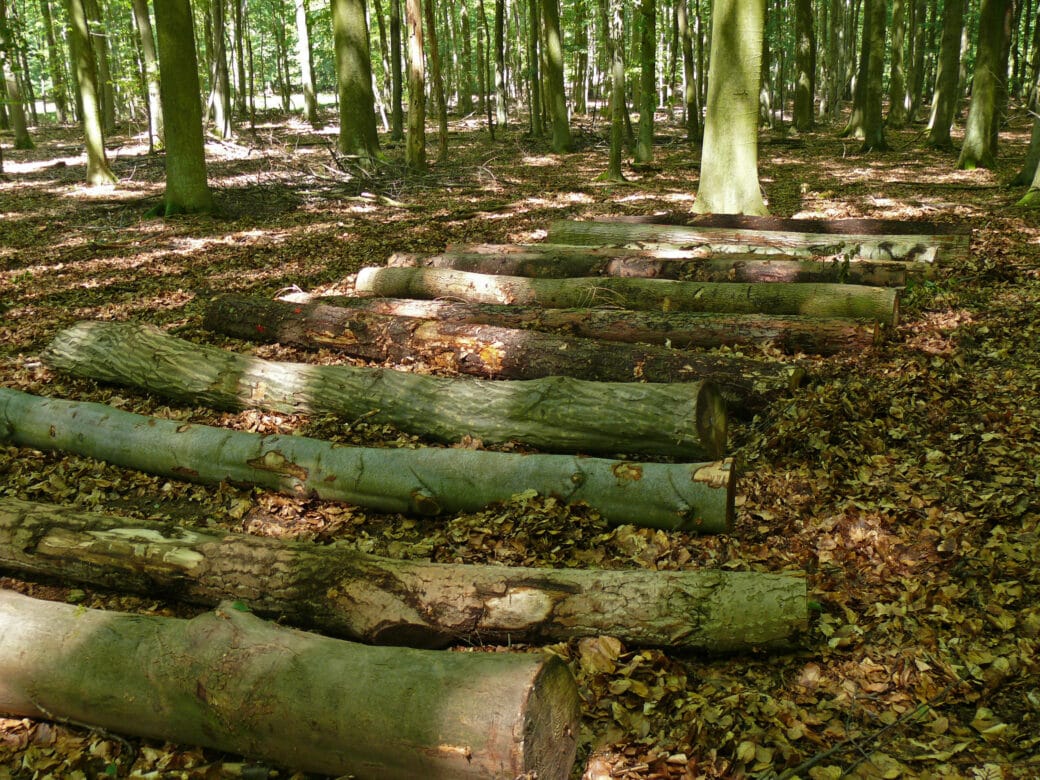Langzeitmonitoring Totholz (BELongDead)
Das von Prof. E.-D. Schulze (em., MPI Biogeochemie Jena) in der zweiten Phase etablierte Langzeitexperiment wird seit der dritten Phase von Prof. Dr. Wolfgang Weisser (TU München, Lehrstuhl für Terrestrische Ökologie) koordiniert.
BELongDead ist kein finanziertes Projekt, sondern vielmehr ein Experiment bei dem Wissenschaftler verschiedener Interessengebiete ökologische Abbauprozesse von Totholz untersuchen. Die Forschung an den BELongDead Stämmen erfolgt durch eigene finanzierte Projekte der Wissenschaftler.

- Was ist die Bedeutung von Totholz in Ökosystemprozessen?
- Wie ist der Einfluss des umliegenden Habitats?
- Wie verläuft die Ansiedlung von Arten und die Zersetzung des Totholzes?
- Wie beeinflusst die Zersetzung den Kohlenstoffhaushalt und die Mikroorganismen an der Bodenoberfläche?
2008 wurden in den drei Regionen der Exploratorien auf jedem Wald-VIP folgende Baumarten in drei Wiederholungen ausgelegt (insgesamt 1140 Totholzstämme):
Buche, Eiche, Ahorn (Spitz-, Berg- und Feldahorn in Mischung), Linde, Pappel, Hainbuche, Esche, Birke und Kirsche (ein Stamm je VIP) sowie Kiefer, Lärche, Douglasie und Fichte.
Jeder Totholzstamm hat einen Mittendurchmesser von ca. 30cm und eine Länge von 4m.
Zu Beginn des Experimentes wurde neben jedem Stamm eine Bodenprobe genommen, getrocknet und eingelagert sowie eine Stammscheibe abgeschnitten und eingelagert.
| Projektname | Verantwortlicher, Institution | Inhalt |
| Arthropods seit 2011 | Blüthgen (Technische Universität Darmstadt)
Weisser (Technische Universität München) |
Besiedlungsdichte und Diversität xylobionter Arthropoden,
Monitoring totholzbesiedelnder Insekten |
| BEL-FFD-HZG seit 2014 | Hofrichter, Kellner (TU Dresden, Internationales Hochschulinstitut Zittau)
Buscot (Helmholtz Zentrum für Umweltforschung Halle) Bässler (Nationalpark Bayrischer Wald) Hoppe (Julius-Kühn-Institut) |
Einfluss des Ökosystems auf Totholzabbau,
Ablauf der Totholzbesiedlung, Einfluss von Mikroorganismen auf Totholzabbau und Ökosystemprozesse, Diversität von Pilzen und Bakterien im Totholz und die Expression von holzabbaurelevaten Genen |
| Projektname | Verantwortlicher, Institution | Inhalt |
| Arthropoden I (2009-2014) | Weißer, Gossner (Technische Universität München) | Besiedlungsdichte und Diversität xylobionter Arthropoden Monitoring totholzbesiedelnder Insekten
Befall durch Trypodendron und Xyleborus, |
| Arthropoden II (2009-2014) | Linsenmair (emeritus MPI BGC Jena)
Steffan-Dewenter (Universität Würzburg) |
Untersuchung xylobionter Arthropoden in Baumkronen und Totholz am Boden |
| Arthropods (2014-2017) | Weisser (Technische Universität München) | Besiedlungsdichte und Diversität xylobionter Arthropoden Monitoring totholzbesiedelnder Insekten |
| Arthropods (2017-2020) | Weisser (Technische Universität München) | Besiedlungsdichte und Diversität xylobionter Arthropoden Monitoring totholzbesiedelnder Insekten |
| Arthropods (2020-2023) | Blüthgen (Technische Universität Darmstadt)
Weisser (Technische Universität München) |
Besiedlungsdichte und Diversität xylobionter Arthropoden Monitoring totholzbesiedelnder Insekten |
| BELongDead (2009) | Schulze (Emeritus, Max-Planck-Institut für Biogeochemie)
Weisser (Technische Universität München) |
Initialmessungen zum Beginn des Projektes (z.B. Durchmesser, Stammbedeckung) |
| BEL-FFD-HZG (2014 – 2017) | Hofrichter, Kellner (Internationales Hochschulinstitut Zittau)
Krüger, Hoppe (Helmholtz Zentrum für Umweltforschung) Bässler (Nationalpark Bayrischer Wald) |
Diversität von Pilzen und Bakterien im Totholz und die Expression von holzabbaurelevaten Genen |
| BEL-FFD-HZG II (2017 – 2020) | Hofrichter, Kellner, Leonhardt (Internationales Hochschulinstitut Zittau)
Hoppe, Moll (Helmholtz Zentrum für Umweltforschung) Bässler (Nationalpark Bayrischer Wald) |
Diversität von Pilzen und Bakterien im Totholz und die Expression von holzabbaurelevaten Genen |
| BELongDead – Stoffflüsse (2009 – 2014) | Matzner (Universität Bayreuth) | Messung von Stammabfluss und Freisetzung von DOC und DON |
| FRASS (2011 – 2014) | Maraun (Universität Göttingen) | Fortpflanzungsverhalten von Oribatidenarten auf Borke entlang eines Landnutzungsgradients |
| Funwood (2009 – 2011) | Bauhus, Kahl (Universität Freiburg) Krüger, Hoppe (Helmholtz Zentrum für Umweltforschung) Hofrichter, Kellner (Internationales Hochschulinstitut Zittau)Otto (Universität Leipzig) |
Auswirkungen der Intensität von Waldmanagement auf die Diversität von holzzersetzenden Pilzen und Totholzabbau, Pilzmonitoring |
| Funwood II (2011 – 2014) | Bauhus, Kahl (Universität Freiburg)
Krüger, Hoppe (Helmholtz Zentrum für Umweltforschung) Otto (Universität Leipzig) Hofrichter, Kellner (Internationales Hochschulinstitut Zittau) |
Auswirkungen der Intensität von Waldmanagement auf die Diversität von holzzersetzenden Pilzen und Totholzabbau, Pilzmonitoring |
| Funwood III (2014 – 2017) | Bauhus, Kahl (Universität Freiburg) | Totholzabbau durch holzzersetzende Pilze unter Berücksichtigung von Bewirtschaftungsintensität |
| Funwood IV (2017-2020) | Jehmlich (Helmholtz Zentrum für Umweltforschung)
Noll (Hochschule Coburg) |
Funktionelle Diversität totholzabbauender Lebensgemeinschaften, Einfluss wechselnder Temperaturbedingungen auf holzabbauende Lebensgemeinschaft, Einfluss von Waldbewirtschaftungsintensität und Baumart auf holzabbauende Lebensgemeinschaft und Totholzabbau |
| Woodsoil (2017-2020) | Borken (Universität Bayreuth)
Persoh (Universität Bochum) |
Nährstofftranslokation durch Bodenpilzgemeinschaften,
funktionelle Diversität totholzbesiedelnder Pilze, mikrobielle Biomasse und Aktivität |









